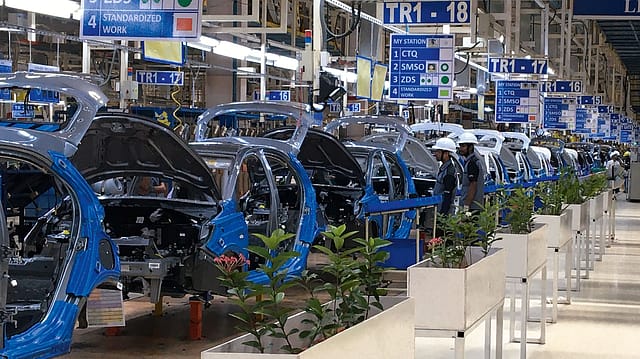Indian ancillaries cautious amid US auto workers' strike
ADVERTISEMENT

The domestic automobile component industry is "closely monitoring" the situation as the US automobile workers' strike against General Motors, Ford and Stellantis entered the sixth day on Thursday, according to the Automotive Component Manufacturers Association (ACMA) of India.
"When it comes to Indian auto component exports, the North American market plays a crucial role. We are closely monitoring the developments in Detroit and remain hopeful that any issues will be resolved in a mutually beneficial manner for both the workers and the industry," says Vinnie Mehta, Director General, ACMA.
North America accounts for 32% of the domestic auto components exports. In FY23, the exports in the North American market grew by 8%. The key export items included drive transmission and steering, engine components, body/chassis, suspension and breaking, etc. Meanwhile, North America accounts for 26% of total imports. In FY23, imports from North America grew by 23%.
Sona Comstar, Bharat Forge, Matherson Group and Sundaram Fasteners are among the leading automobile ancillaries that export to the US. In an exchange filing, Sona Comstar says there may be a higher potential impact due to automobile workers' strikes in the US. "We would like to inform that United Auto Workers (UAW) in the United States of America went on strike at some of the plants of three Original Equipment Manufacturers (OEMs) on 15th September, 2023. The Company supplies these three OEMs in the United States, directly or indirectly. We are monitoring the situation closely. There is minimal impact on the sales of the Company currently, but there may be higher potential impact if this strike persists for long or extends to the other plants," says Sona Comstar.
January 2026
Netflix, which has been in India for a decade, has successfully struck a balance between high-class premium content and pricing that attracts a range of customers. Find out how the U.S. streaming giant evolved in India, plus an exclusive interview with CEO Ted Sarandos. Also read about the Best Investments for 2026, and how rising growth and easing inflation will come in handy for finance minister Nirmala Sitharaman as she prepares Budget 2026.
Why are auto workers in the US on strike
Touted to be historical, as many as 13,000 workers in Detroit went on strike beginning September 15 against the ‘Big Three’ automobile companies— General Motors, Ford and Stellantis (manufacturer of Chrysler and Jeep) — after discussions regarding better pay hikes between the United Auto Workers (UAW) and the automobile manufacturers failed. UAW represents an estimated 1,50,000 automobile workers in the US.
The UAW is reportedly seeking a 40% wage hike over four years, citing less pay to the workers even as the three automobile manufacturers reaped maximum benefits in the past 10 years. The union is reportedly seeking compensation for the low pay hike over the past years and benefits the union let go after the 2008 financial crisis, as the automakers struggled to find footing.
General Motors and Ford have reportedly offered a 20% wage hike, whereas Stellantis is offering a 17.5% hike in the workers' wages.
